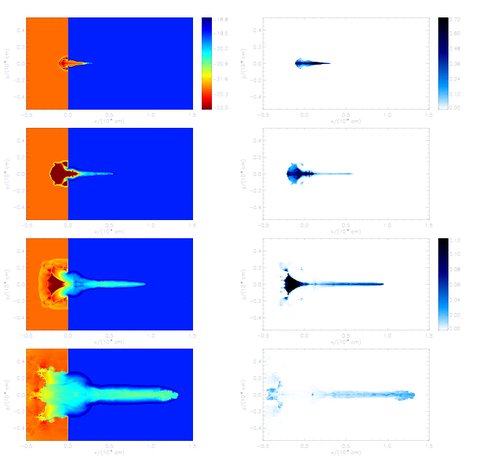2012 Annual Science Report
 Arizona State University
Reporting | SEP 2011 – AUG 2012
Arizona State University
Reporting | SEP 2011 – AUG 2012
Astrophysical Controls on the Elements of Life, Task 3: Model the Injection of Supernova Material Into Star-Forming Molecular Clouds
Project Summary
The goal of this task is to see if material ejected from a star that has exploded as a supernova can make its way into the gas as it is forming new solar systems. It has been expected that this material, because it is moving so fast (> 2000 km/s) when it hits the cold, dense molecular cloud in which stars are forming, would shock, heat up, and then “bounce” off of the cloud boundary. Our numerical modeling using state-of-the-art numerical codes and thousands of computers at the Arizona Center for Advanced Computing, shows that the gas can in fact cool quickly enough to penetrate into the molecular cloud. Stars can be contaminated with supernova material just as they are forming, at contamination levels consistent with isotopic and chemical evidence from meteorites.
Project Progress
This year we made great progress on quantifying how well an exploding supernova could inject material into nearby molecular clouds that are forming protostars. This was the major goal of Task 3 and we are happy to finally have some definite answers. The research resulted in 2 conference abstracts and culminated in the refereed publication, “Mixing of Clumpy Supernova Ejecta into Molecular Clouds”, by Liubin Pan, Steve Desch, Evan Scannapieco and Frank Timmes. A figure from that paper is found below. We carried out state-of-the-art adaptive-mesh-refinement hydrodynamic simulations of how a clump of supernova material would interact with a molecular cloud, using the FLASH code run on thousands of processors at the Arizona Center for Advanced Computing. AWe generally conclude that supernova material in will not mix into a molecular cloud unless it is clumpy, but that if the density structure of the ejecta resembles the clumpy Cassiopeia A supernova remnant ejecta, then the clumps, or “bullets” of supernova material will penetrate mix in the molecular cloud, to depths ~ 0.5 pc. The high ejecta velocities and broad range of relevant lengthscales made these calculations technically very challenging. Cooling instabilities that fragment the material were found to be very important, hindering numerical convergence and complete validation of the results. But we can state with confidence that supernova material will mix into nearby molecular clouds, so that all stars forming late (> 4 Myr) into the lifetime of a massive cluster will be contaminated with supernova material at a mass fraction ~ 10-4. This is exactly the shift needed to explain the abundances of short-lived radio-nuclides like 26Al. We are now trying to assess the shifts in stable isotopes due to supernova injection.
Figure 1: Time sequence (from top to bottom) of how supernova material can be injected into a molecular cloud. (Left): Density of gas. Densities vary from the orange density 10-22 g cm-3 of the ionized gas near the massive star (which has just exploded as a supernova) up to the “blue” density 10-19 g cm-3 of the nearby molecular cloud (from which the massive star was born). The bullet of supernova material is ~ 0.003 pc in radius, much smaller than the parsecs scale of the computational domain. The bullet travels from left to right at initial speeds > 2000 km/s, penetrating into the molecular cloud, sending out lateral shock waves that expand the channel. The bullet is stopped after 10,000 yr at a depth of 0.5 pc. (Right): the same sequence, but showing the concentration of ejecta material. By 10,000 years the supernova material has been spread evenly along the channel, and is expected to mix thoroughly in the lateral direction due to (unmodeled) turbulence.
-
PROJECT INVESTIGATORS:
-
PROJECT MEMBERS:
Evan Scannapieco
Collaborator
Francis Timmes
Collaborator
Patrick Young
Collaborator
Liubin Pan
Postdoc
Carola Ellinger
Graduate Student
-
RELATED OBJECTIVES:
Objective 1.1
Formation and evolution of habitable planets.
Objective 3.1
Sources of prebiotic materials and catalysts

